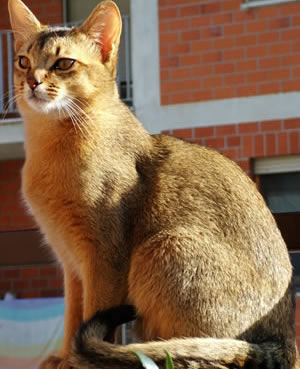Breed Standard
Head: Wedge-shaped , with slightly rounded contours); without flat planes . Arched brow. The moderately long nose bridge must never be straight; no break. The profile lines of the head show a gentle contour. Jowls are allowed in mature males. . Muzzle not sharply pointed; no whisker pinch. Strong, well-developed, rounded chin, neither receding nor protruding.
Eyes: Large, almond-shaped, wide-set. Accentuated by a fine dark line of the base color and encircled by a light-colored area. Brilliant, expressive, of one intense color. Yellow (gold), green, and amber.
Neck: Rather long and gracefully arched.
Body: Medium in length and build, lithe, strong, and muscular. Rounded rib cage. Slightly arched back.
Paw: Long, straight, fine-boned. small, oval, compact paws. The cat gives the impression of being on tiptoe.
Tail: Fairly long, thick at the base and tapering to the tip.
Coat: Thick, dense, and resilient to the touch, lying close against the skin. Short in length or medium particularly along the spine. Ticking (two or three bands of alternating dark or light color on each hair shaft) similar to the coat of a rabbit. Ticking is not present on the throat, underside, or inside of legs.
History
The exact origins of the Abyssinian, one of the oldest breeds, remain a mystery. Perhaps it originated in Ethiopia, formally known as Abyssinia. Unfortunately, there is no record of agouti cats in Ethiopia. Nevertheless, since it resembles the sacred cat of Ancient Egypt, legend holds that the Abyssinian was born along the banks of the Nile. In fact, it is said that Ramses II asked the king of Abyssinia for a band of cats to take back to Egypt. Cats sporting a coat similar to the Abyssinian can also be found in Africa, Eurasia, and Asia, including Felis Libyca, the African Wild Cat or Gloved Cat, and Felis chaus, the Swamp Cat or Jungle Cat. However, the existence of ticked coloring in India and Asia makes it more likely that the Abyssinian originated in Asia.
Behavior
Abyssinians are extroverted, extremely active, playful, wilful and intelligent. They are usually not "lap cats", because they are usually too preoccupied with exploring and playing. They are popular among breeders and owners, and can be very successful show cats. Not all Abyssinians are shown, however, because the color and type standards are very exacting, and because some are shy towards strangers and timid in public. They have quiet, engaging voices.
"Abys", as they are affectionately referred to by their fans, need a great deal of love and interaction with the family to keep them happy and can get depressed without daily activity and attention. They generally get along well with other cats. Abyssinians are known for their curiosity and enjoy exploring their surroundings, including heights. They are sensible cats that do not take unnecessary risks. As one might expect from such an intelligent and physically capable breed, Abyssinians are known to be formidable hunters. They adore toys and can play for hours with a favorite ball. Some play fetch.
Health
Abyssinians are generally healthy, but as with all breeds, they are prone to certain health conditions. While knowledgeable breeders do their best to test for and eliminate genetic health problems, cats may still develop certain diseases or conditions. Abyssinians may have a higher risk for the following:
PK-Def (Pyruvate Kinase Deficiency) Pk-def is a hereditary form of anemia
PRA (Progressive Retinal Atrophy) PRA is a hereditary disease of the retina in the eye that eventually leads to permanent blindness.
PL (Patella Luxation) PL is a defect where the kneecap (patella) has a tendency to slip out of its position, it luxates.
RA (Renal Amyloidosis) Unfortunately there is no DNA/genetic testing for RA. This is a disease in which an amyloid substance accumulates in the cells of the kidney (and possibly in other organs such as the thyroid gland, stomach and spleen).
It is important to note that PK-Def and PRA can be diagnosed through genetic testing so be sure to ask for certification from the breeder.
The breed can be prone to gingivitis, which can lead to more serious periodontitis. Familial renal amyloidosis or AA amyloidosis, a kidney disorder due to a mutation in the AA amyloid protein gene, has been seen in Abyssinians. The Abyssinian has had severe problems with blindness caused by a hereditary retinal degeneration due to mutations in the rdAc gene. However, the prevalence has been reduced from 45% to less than 4% in 2008 in the country of Sweden. With the widespread availability of rdAc mutation detection tests and services, such as those provided by the UC Davis Veterinary Genetics Laboratory, it is possible to reduce the disease frequency in all populations of Abyssinian.






